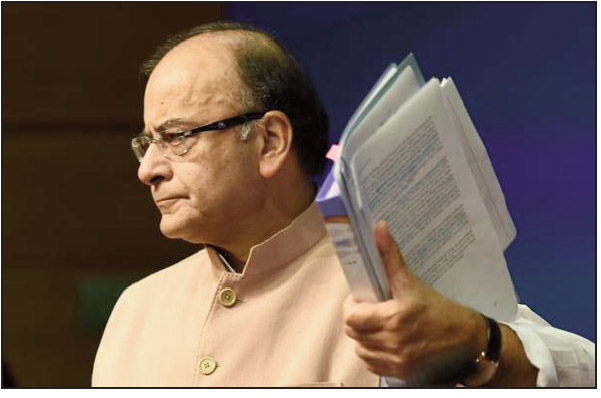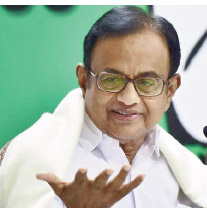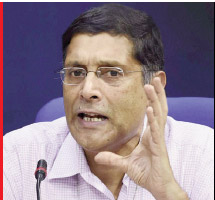Rhetoric doesn't make it shine !
 K R Sudhaman
K R Sudhaman
 Finance Minister Arun Jaitley
has attempted to do what he
ought to have done long ago
because he cannot ignore
the sentiments of farmers,
informal sectors and rural
folk, who have been in distress.
Imperfect rollout of GST, and
demonetisation have rattled the farm
and rural sectors, mainly dependent on
cash economy.
Finance Minister Arun Jaitley
has attempted to do what he
ought to have done long ago
because he cannot ignore
the sentiments of farmers,
informal sectors and rural
folk, who have been in distress.
Imperfect rollout of GST, and
demonetisation have rattled the farm
and rural sectors, mainly dependent on
cash economy.
Taking the cue from the Economic
Survey, which had highlighted three
areas that needed attention
immediately, Jaitley has outlined the
intent to uplift the sagging morale of
farmers and rural poor but without
making necessary allocation.This is
surprising indeed in what is an election
year. Result: Yet another grand
promise like Narendra Modi's 2014
campaign promise of putting Rs 15
lakh in every poor family's bank
account by getting back the black
money stashed abroad.
Jaitley has tried to provide an
impetus to the rural economy,
which would be a force multiplier for overall growth to surge towards
eight per cent. One of these
measures is 150 per cent increase in
Minimum Support Price (MSP) for
the forthcoming Kharif crop with a
promise to ensure 1.5 times more
farm income. Cost plus 50 per cent profit formula,
as suggested by the Swaminathan
committee,would help in moving
towards doubling farm income by
2022. Four years have passed since
Prime Minister Modi had held out the
promise but not much headway has
been made so far.
The proposed MSP hike is just a
beginning. Huge resources have to be
tied up as otherwise it will remain an
intent. It is going to be a tough task as
calculation of cost taking into
consideration land value will be
difficult since there is big variation in
cost of land across country.
The budget script on
rural India is good but
lacks seriousness.
There are no answers
as to how the
government is going to
get the wherewithal for
implementation. The
new health care
scheme may cost the
exchequer at least Rs
1.5 lakh crore. No
allocation was made
for this.
MSMEs account for nearly 40 per
cent of manufacturing and 45 per cent
of exports. These small and medium
companies' employ many times more
compared to large industries, which
are increasingly becoming capital
intensive.The budget offers a package
to pump-prime their growth through
better access to finance; it helps to spur
both employment and growth in this
vital segment of the economy. This will
also help to solve the problem of
disguised unemployment in rural
areas.
Measures to step up irrigation,
particularly minor irrigation and linking
of peninsular rivers, are long overdue
to bring more area under irrigated
farming. Though India has largest
irrigated area in the world, still only 45-
50 per cent of the arable land is
irrigated. More irrigation in the long
run will minimise rain-fed farming.
 P Chidambaram
Water management, too, is equally
important in view of growing scarcity of
water and the budget caters to
stepping up drip and sprinkler
irrigation across the country.
Boost to rural livelihoods proposed
in the budget is a welcome
development. The total amount to be
spent by various Ministries will be
Rs.14.34 lakh crore, including extrabudgetary
and non-budgetary
resources of Rs.11.98 lakh crore.
P Chidambaram
Water management, too, is equally
important in view of growing scarcity of
water and the budget caters to
stepping up drip and sprinkler
irrigation across the country.
Boost to rural livelihoods proposed
in the budget is a welcome
development. The total amount to be
spent by various Ministries will be
Rs.14.34 lakh crore, including extrabudgetary
and non-budgetary
resources of Rs.11.98 lakh crore.
 Arvind Subramanian
Water management, too, is equally
important in view of growing scarcity of
water and the budget caters to
stepping up drip and sprinkler
irrigation across the country.
Boost to rural livelihoods proposed
in the budget is a welcome
development. The total amount to be
spent by various Ministries will be
Rs.14.34 lakh crore, including extrabudgetary
and non-budgetary
resources of Rs.11.98 lakh crore.
Arvind Subramanian
Water management, too, is equally
important in view of growing scarcity of
water and the budget caters to
stepping up drip and sprinkler
irrigation across the country.
Boost to rural livelihoods proposed
in the budget is a welcome
development. The total amount to be
spent by various Ministries will be
Rs.14.34 lakh crore, including extrabudgetary
and non-budgetary
resources of Rs.11.98 lakh crore.
Apart from employment due to
farming activities and selfemployment,
this expenditure will
create employment of 321 crore
person days, 3.17 lakh kilometers of
rural roads, 51 lakh new rural houses,
1.88 crore toilets, and provide 1.75
crore new household electric
connections besides boosting
agricultural growth.
Accordingly, the Government
substantially increased the allocation
of National Rural Livelihood Mission to
Rs. 5750 crore in 2018-19. Loans to Self
Help Groups (SHGs) of women has
been increased to about Rs. 42,500
crore, up by 37 per cent over previous
year. The Government is confident
that loans to SHGs will increase to
Rs.75, 000 crore by March, 2019. This is
something positive and a realistic
development for rural India.
The government would have done
well had it revived the move to allow
FDI in multi-brand retail. Nearly 70 per
cent of the sales in multi-brand retail
are food items and encouraging this
sector would have helped farmers get
remunerative prices. This would have
eliminated middlemen to a great
extent.
Multi-brand retail today is around $
500 billion industry; it is expected to
double to $1000 billion in the next five
to seven years considering India grows
at a rate of around 7-8 per cent. This is
one area the BJP does not seem to be
interested in looking at as traders are
the saffron party's core constituency.
In short, the budget script on rural
India is good but lacks seriousness as
there are no answers how the
government is going to get the
wherewithal for implementation.
Like for the new health care, which is a
grandiose intent by all means. It may
cost the exchequer at least Rs 1.5 lakh
crore. No allocation was made.
Some six states already have a more
modest version of the health scheme.
Tamil Nadu has been implementing its
universal health care since 2008; it is
working well because the state already
has a good hospital network. Many
government hospitals are able to pay
for their upkeep from the money they
get from insurance companies.
Hitherto Tamil Nadu hospitals used to
wear a pathetic look because of
inadequate government funding.
Many of states in the north, east and
northeast India do not have a good
hospital network. In Uttar Pradesh and
Bihar even government hospitals and
primary health centres (PHCs) are in a
bad shape.For a successful launch of
national health scheme, hospital
network needs to be first improved in
these states. It will take several years to
accomplish the task.
The health care scheme, to be
known as Modicare, just as
Obamacare, may take years to be
rolled out fully as huge resources
would have to be found even if states
were to share a part of the burden as
proposed.
Also, experience shows any Central
programme implemented in
collaboration with states tends to be
tardy as the level of implementation
and quality vary from state to state.
The rollout, therefore, is going to be
difficult and it could lead to serious
fiscal slippages just when the economy
is showing robust growth and broadbased
revival.
Such mega plans for rural India are
good if India is to shine for all. But the
question is: Can it be implemented
without glitches and spreading thin the
scarce resources ahead of elections
next year? The answer is big no.
Arun Jaitley's health scheme for 10
crore below poverty families, which
translate to 50 crore persons, is like the
UPA government's food security
programme announced ahead of the
2014 elections. Food subsidy bill was
estimated at a whopping Rs 1.25 lakh
crore but the UPA-2 made no proper
provisioning in the budget. Rural
people saw through the game and the
UPA lost the elections.
It would have been better if the
Modi government had held discussions
with all stakeholders and created
necessary infrastructure and resources
before announcing the scheme.
Perhaps, Modicare could have been
a good promise in the manifesto for
2019 elections as failure to implement
it in the short span of one year could
cost the ruling party dearly at the
hustings.
Former finance minister P
Chidambaram is right in saying that
Arvind Subramanian, the chief
economic advisor, who authored
the Economic Survey, is a good
doctor as he has rightly flagged the
ills of the economy but the Modi
government seems to be a bad
patient as it has failed to listen to
the advice of the doctor.
The writer is formerly
Economic Editor at Press
Trust of India (PTI) and
The Financial Chronicle




 K R Sudhaman
K R Sudhaman
 P Chidambaram
P Chidambaram Arvind Subramanian
Arvind Subramanian